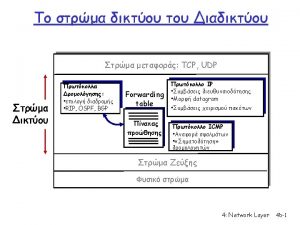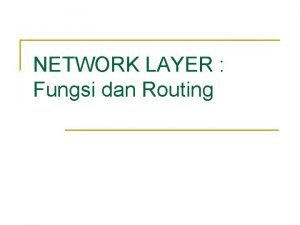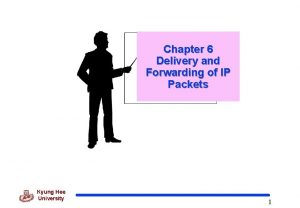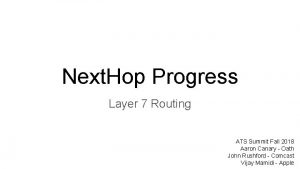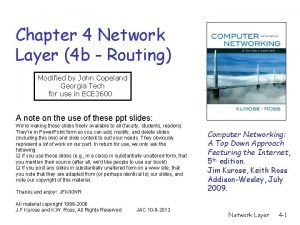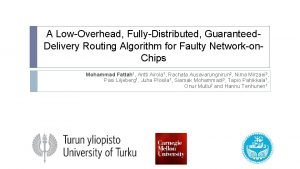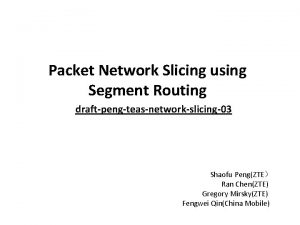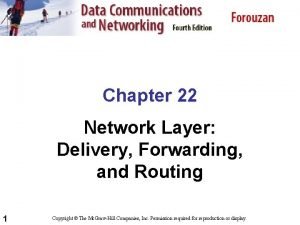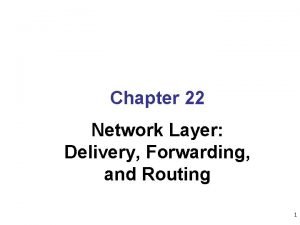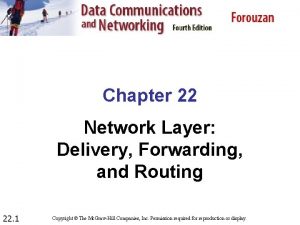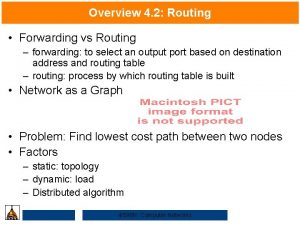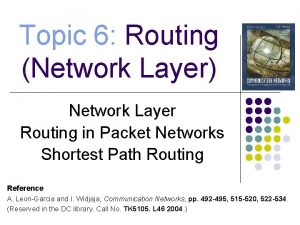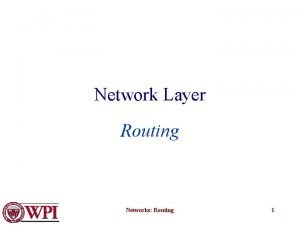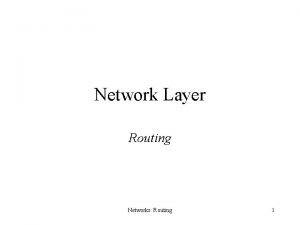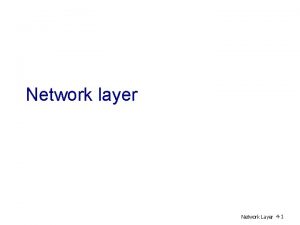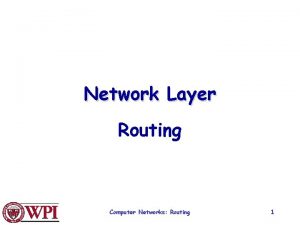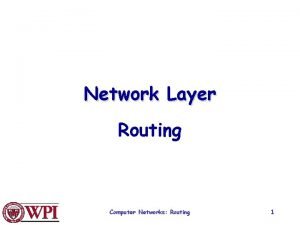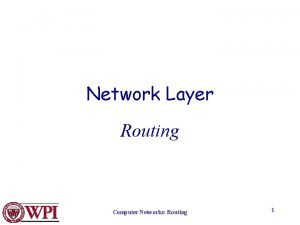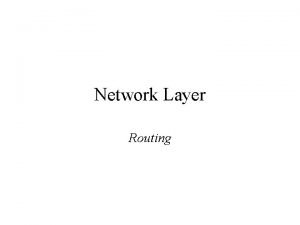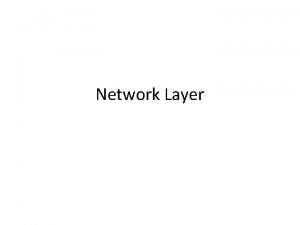Chapter 22 Network Layer Delivery Forwarding and Routing





![Static Route Configuration Router(config)#ip route network [mask] {address | interface}[distance] [permanent] • Defines a Static Route Configuration Router(config)#ip route network [mask] {address | interface}[distance] [permanent] • Defines a](https://slidetodoc.com/presentation_image/f1d7ac384fffbc1cc8803d20b6a7f6f9/image-6.jpg)














- Slides: 20

Chapter 22 Network Layer: Delivery, Forwarding, and Routing

What Is Routing? 10. 120. 2. 0 172. 16. 1. 0 • To route, a router needs to do the following: – Know the destination address. – Identify the sources it can learn from. – Discover possible routes. – Select the best route. – Maintain and verify routing information.

What Is Routing? (cont. ) 10. 120. 2. 0 E 0 172. 16. 1. 0 S 0 Network Protocol Connected Learned Destination Network 10. 120. 2. 0 172. 16. 1. 0 Exit Interface E 0 S 0 Routed Protocol: IP • Routers must learn destinations that are not directly connected.

Identifying Static and Dynamic Routes Static Route • Uses a route that a network administrator enters into the router manually Dynamic Route • Uses a route that a network routing protocol adjusts automatically for topology or traffic changes

Static Routes Stub Network 172. 16. 1. 0 S 0 Network A 172. 16. 2. 2 172. 16. 2. 1 B B • Configure unidirectional static routes to and from a stub network to allow communications to occur.
![Static Route Configuration Routerconfigip route network mask address interfacedistance permanent Defines a Static Route Configuration Router(config)#ip route network [mask] {address | interface}[distance] [permanent] • Defines a](https://slidetodoc.com/presentation_image/f1d7ac384fffbc1cc8803d20b6a7f6f9/image-6.jpg)
Static Route Configuration Router(config)#ip route network [mask] {address | interface}[distance] [permanent] • Defines a path to an IP destination network or subnet

Static Route Example Stub Network 172. 16. 1. 0 S 0 Network 10. 0 A 172. 16. 2. 2 172. 16. 2. 1 B B ip route 172. 16. 1. 0 255. 0 172. 16. 2. 1 • This is a unidirectional route. You must have a route configured in the opposite direction.

Default Routes Stub Network 172. 16. 1. 0 Network 10. 0 S 0 A 172. 16. 2. 2 172. 16. 2. 1 BB ip route 0. 0 172. 16. 2. 2 • This route allows the stub network to reach all known networks beyond router A.

What Is a Routing Protocol? 10. 120. 2. 0 • Routing protocols are used between routers to determine paths and maintain routing tables. • Once the path is determined, a router can route a routed protocol. E 0 Network Protocol Connected RIP IGRP 172. 16. 1. 0 S 0 Destination Network 10. 120. 2. 0 172. 16. 2. 0 172. 17. 3. 0 Exit Interface E 0 S 1 Routed Protocol: IP Routing Protocol: RIP, IGRP 172. 17. 3. 0

Autonomous Systems: Interior or Exterior Routing Protocols IGPs: RIP, IGRP EGPs: BGP Autonomous System 100 Autonomous System 200 • An autonomous system is a collection of networks under a common administrative domain. • IGPs operate within an autonomous system. • EGPs connect different autonomous systems.

Administrative Distance: Ranking Routes I need to send a packet to network E. Both routers B IGRP Administrative Distance = 100 and C will get it there. Which route is best? Router A Router B RIP Administrative Distance = 120 E Router C Router D

Classes of Routing Protocols B Distance Vector A C D Hybrid Routing B A C D Link State

Distance Vector Routing Protocols B A C Distance—How Far Vector—In Which Direction D D C B A Routing Table • Pass periodic copies of routing table to neighbor routers and accumulate distance vectors

Distance Vector—Sources of Information and Discovering Routes 10. 1. 0. 0 E 0 10. 2. 0. 0 A S 0 Routing Table S 0 10. 3. 0. 0 B S 1 Routing Table 10. 4. 0. 0 S 0 C E 0 Routing Table 10. 1. 0. 0 E 0 0 10. 2. 0. 0 S 0 0 10. 3. 0. 0 S 1 0 10. 4. 0. 0 E 0 0 • Routers discover the best path to destinations from each neighbor.

Distance Vector—Sources of Information and Discovering Routes 10. 1. 0. 0 E 0 10. 2. 0. 0 A S 0 Routing Table S 0 10. 3. 0. 0 B S 1 Routing Table 10. 4. 0. 0 S 0 C E 0 Routing Table 10. 1. 0. 0 E 0 0 10. 2. 0. 0 S 0 0 10. 3. 0. 0 S 1 0 10. 4. 0. 0 E 0 0 10. 3. 0. 0 S 0 1 10. 4. 0. 0 S 1 1 10. 2. 0. 0 S 0 1 10. 1. 0. 0 S 0 1 • Routers discover the best path to destinations from each neighbor

Distance Vector—Sources of Information and Discovering Routes 10. 1. 0. 0 E 0 10. 2. 0. 0 A S 0 Routing Table S 0 10. 3. 0. 0 B S 1 Routing Table 10. 4. 0. 0 S 0 C E 0 Routing Table 10. 1. 0. 0 E 0 0 10. 2. 0. 0 S 0 0 10. 3. 0. 0 S 1 0 10. 4. 0. 0 E 0 0 10. 3. 0. 0 S 0 1 10. 4. 0. 0 S 1 1 10. 2. 0. 0 S 0 1 10. 4. 0. 0 S 0 2 10. 1. 0. 0 S 0 1 10. 1. 0. 0 S 0 2 • Routers discover the best path to destinations from each neighbor.

Distance Vector—Selecting Best Route with Metrics A IGRP Bandwidth 56 Delay RIP Hop Count Load T 1 56 Reliability IPX Ticks, Hop Count MTU T 1 B • Information used to select the best path for routing

Distance Vector—Maintaining Routing Information Process to Update this Routing Table A • Updates proceed step-by-step from router to router Topology Change Causes Routing Table Update

Distance Vector—Maintaining Routing Information Process to Update This Routing Table Router A Sends Out This Updated Routing Table After the Next Period Expires A • Updates proceed step-by-step from router to router. Topology Change Causes Routing Table Update

Distance Vector—Maintaining Routing Information Process to Update This Routing Table B Process to Update This Routing Table Router A Sends Out This Updated Routing Table After the Next Period Expires A • Updates proceed step-by-step from router to router. Topology Change Causes Routing Table Update
 Interplay between routing and forwarding
Interplay between routing and forwarding Fungsi network layer adalah …
Fungsi network layer adalah … Delivery and routing of ip packets
Delivery and routing of ip packets Delivery and forwarding of ip packets
Delivery and forwarding of ip packets Difference between channel routing and reservoir routing
Difference between channel routing and reservoir routing Mark tinka
Mark tinka Continuity equation hydrology
Continuity equation hydrology Power routing in vlsi
Power routing in vlsi Routing and switching protocols
Routing and switching protocols Arg
Arg Layer 4 routing
Layer 4 routing Delivery routing algorithms
Delivery routing algorithms Fig 19
Fig 19 Pharynx
Pharynx Secure socket layer and transport layer security
Secure socket layer and transport layer security Secure socket layer and transport layer security
Secure socket layer and transport layer security Secure socket layer and transport layer security
Secure socket layer and transport layer security Secure socket layer and transport layer security
Secure socket layer and transport layer security Network slicing with segment routing
Network slicing with segment routing Presentation layer functions
Presentation layer functions Layer 2 e layer 3
Layer 2 e layer 3
